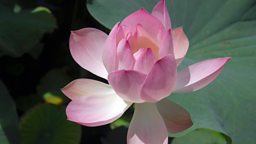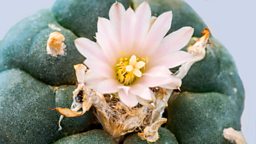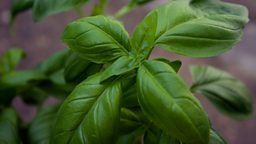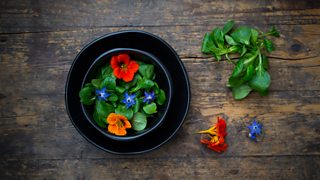Seven of the most sacred plants in the world
Musician Jahnavi Harrison has been exploring ‘Sacred Botany’ in Something Understood. In many religious traditions plants are seen as spiritually symbolic – nourishing, delighting, healing and sometimes acting as intermediaries with the divine world.
From the lotus flower in the East, to basil in the West, here are seven of our most sacred plants, past and present, what they symbolise to who, and why.
1. Lotus Flower

Jahnavi Harrison explains how the lotus is a plant that, for those educated in an eastern spiritual context, evokes layers of meaning and narrative. For Hindus, the beautiful and arresting lotus flower represents life, fertility and (as with Buddhists) purity – standing aloof above the mud and murk from which it grows. Though its roots are in the mud, the flower sits atop the water, clean and white.
The story goes that the lotus arose from the navel of God Vishnu, with Brahma sitting at the centre of the flower. Some believe that God’s hands and feet are lotus-like and his eyes shaped like lotus petals; his glance and touch are said to be as soft as lotus buds. Hinduism also teaches that within each person is the spirit of the sacred lotus. Flower power!
2. Mistletoe

We now associate mistletoe with the magic of Christmas, but its symbolism dates back to the days of the ancient Celtic Druids. They believed that mistletoe represented the essence of the sun god Taranis and that any tree with mistletoe growing amongst its branches was therefore sacred.
The winter solstice was the time when the Chief Druid, dressed in a white cloak, would cut the sacred mistletoe from the oak tree with a golden sickle. The special plant and its berries would then be used for rituals or medicine. It was believed to hold miraculous properties: a potion made from mistletoe would cure illness, serve as an antidote against any poison, ensure fertility in humans and animals and protect against witchcraft. In actual fact, this was extremely ill-advised – mistletoe is toxic when ingested!
3. Holy Basil (Ocimum Sanctum)

In Hinduism, the Goddess Vrinda is said to serve Lord Krishna and his devotee’s by acting as guardian of the sacred land of Vindravan, a town of pilgrimage and worship. Although she is a goddess with a human form, ancient texts tell that Krishna himself blessed her to take the form of the holy basil plant within the worldly realm and that wherever she would grow would automatically become akin to the sacred ground of Vrindavan. This holy Basil plant, known as tulsi, grows profusely all over the area.
Millions of Hindus of different denominations, all over the world, worship the tulsi plant as a daily practice, in temples and in their homes
4. Peyote

Peyote is a small, spineless cactus that grows naturally in the desert in southwestern Texas and Mexico and has been used by indigenous people for spiritual purposes for millennia. The Huichol Indians of Mexico and members of many Native American tribes in North America believe peyote to be a sacred plant that helps them converse with God. Used in prayer ceremonies, it can trigger hallucinations that are thought to be visions of an alternate reality or the spirit world.
It isn’t just the indigenous people who have eulogised the spiritual powers of peyote. The cactus’s psychedelic properties garnered it an almost religious following in artists, musicians and writers from around the 1950s. Ken Kesey claimed to have scribed the opening passage of ‘One Flew Over the Cuckoo's Nest’ while he was high on peyote!
5. Yew Tree

The yew tree, an evergreen conifer, has long been associated with rebirth and everlasting life. This is because, incredibly, its drooping branches can take root in the ground and form new trunks. A yew can also grow a new trunk from within the hollow husk of an old tree. It is no wonder that it came to symbolise resurrection!
The yew is a symbolic tree in the Christian faith: there was a custom of placing yew shoots within the coffins of the deceased, and many a church has a yew tree standing next to it. However, although some yew trees have been planted beside churches, in many cases a yew was already growing on a site before the first church was built there. Considered sacred by the Druids in pre-Christian times, these ancient yew trees were in fact originally planted on pagan worship sites, or the site chosen because of the yew, to then be adopted by the church. Well, what do yew know!
6. Marijuana

Marijuana holds great religious significance for the Rastafarian religion. The religion believes that the Tree of Life referred to in the Bible is the marijuana plant and that its use is sacred, based on numerous passages in the bible. For example, Revelation 22:2 states, ‘the herb is the healing of the nations.’
The use of cannabis is an integral part of what Rastafari call ‘reasoning sessions’, which are communal meetings where members discuss life according to the Rasta perspective. Although the substance is known by various names (marijuana, cannabis, and ganja), Rastas also describe it as the ‘holy herb’ or the ‘wisdom weed’ as they believe smoking it provides great wisdom and insight. They see the use of the herb as bringing them closer to God, the universe and their inner spiritual self. The smoking of the ‘wisdom weed’ is a highly ritualised act: it is rolled into a cigarette or placed into a chillum pipe, passed around and inhaled – and before it is smoked a prayer is uttered.
7. Basil (Ocimum Basilicum)

‘Ocimum basilicum’ is the herb most of us know from tearing it on to the top of our spag bol, but within the regional denominations of Orthodox Christianity, especially in the Greek Church, it’s a sacred herb. The name basil in fact comes from the Greek word for ‘kingly’ or ‘royal’.
Orthodox Christians believe the herb sprung up where Jesus's blood fell near his tomb and, ever since, basil has been associated with the worship of the cross, particularly during Great Lent. The priest uses basil to establish and purify the holy water and a bunch of its leaves to sprinkle the water on to the congregation. The cross, decorated with fragrant bouquets of the herb, is taken in procession around the church and small bunches are handed out. Many people will place their bunch in water until it develops roots, so they can replant the basil as a blessing in their own home. No need for potpourri!
-
![]()
Something Understood: Sacred Botany
Musician Jahnavi Harrison examines the sacred plants, rich in spiritual symbolism.
-
![]()
What are the roots of vegetarianism?
The historical roots of vegetarianism, why it began and the rise in interest.
-
![]()
How to get the most out of supermarket herbs
Why don't the herbs bought in pots from the supermarket keep growing?
-
![]()
Seven things you didn’t know about owls
Fascinating facts to celebrate our favourite nocturnal bird, the wise old owl.




